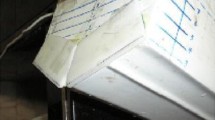Abstract
Nowadays, the use of interceptor by both partial and total dynamic lift crafts is quite common. In this article, a lot of evidence is given regarding the effectiveness of interceptor. The interceptor, when placed at the stern region, changes the pressure distribution around the craft. Its presence affects drag force, lifting force and the position of pressure’s center leading to a new trim. This study focuses on hydrodynamic effects of interceptors on a 2-D flat plate based on both computational fluid dynamic (CFD) and experimental approaches. The Reynolds average Navier-Stokes (RANS) equations are used to model the flow around a fixed flat plate with an interceptor at different heights and attack angles. Based on finite volume method and SIMPLE algorithm which uses static structures, this model can be analyzed and the RANS results can be compared with the experimental data obtained in the current channel of the laboratory of waves and current of COPPE/UFRJ (LOC in Portuguese acronym). According to the results, the increase of pressure at the end of the flat plate was proportional to the interceptor height. In addition, the existence of interceptors can significantly increase the lift force coefficient at high angles of attack also proportional to the interceptor height. The presence of interceptor at the end of the flat plate increased both the lift coefficient and the drag coefficient but hydrodynamic drag did not grow as fast as the lift coefficient did. The lift coefficient increased much more. Furthermore, the results showed that the interceptor effectiveness is proportional to the boundary layer thickness at the end of the flat plate. As the interceptor was inside the boundary layer alterations of flow speed led to changes in boundary layer thickness, directly affecting interceptor’s efficiency. Optimum choice of interceptor height had a great effect on its efficiency, and in choosing it the flow speed and length of the boat must be taken into consideration.
Similar content being viewed by others
References
BLOUNT D. L., Codega L. T. Dynamic stability of planing boats[J]. Marine Technology, 1992, 29(1): 4–12.
IKEDA Y. Stability of high speed craft (Vassalos D. Contemporary ideas on ship stability)[M]. New York, USA: Elsevier ScienceLtd, 2000, 401–409.
ZERAATGAR H., BAKHSHANDEHROSTAMI A. An investigation on ship operability versus equipment operability in irregular waves[J]. Brodogradnja, 2012, 63(1): 30–34.
SAVITSKY D. Hydrodynamic design of planing hulls[J]. Marine Technology, 1964, 1(1): 71–95.
ZERAATGAR H., BAKHSHANDEHROSTAMI A. and NAZARI A. A study on performance of planing-wing hybrid craft[J]. Polish Maritime Research, 2012, 19(4): 16–22.
GHADIMI P., BAKHSHANDEHROSTAMI A. and JAFARKAZEMI F. Aerodynamic analysis of the boundary layer region of symmetric airfoils at ground proximity[J]. Aerospace Science and Technology, 2012, 17(1): 7–20.
KARAFIATHAND G., FISHER S. C. The effect of stern wedges on ship powering performance[J]. Naval Engineers Journal, 1987, 99(3): 27–38.
MOLINI A., BRIZZOLARA S. Hydrodynamics of interceptors: A fundamental study[C]. Proceedings Icmrt 2005, International of Conference on Maritime Research and Transportation. Ischia (Naples), Italy, 2005.
TSAI F. J., HWANG J. L. Study on the compound effects of interceptor with stern flap for two fast monohulls[C]. Oceans’04. Mtts/Ieee Techno-Ocean’04. 2004, 2: 1023–1028.
PELÁEZ G., MARTÍN E. and LAMAS A. M. et al. Preliminary study of a new stern device to improve efficiency in a fishing craft[C]. First International Symposium on Fishing Craft Energy Efficiency. Vigo, Spain, 2010.
BRIZZOLARA S. Hydrodynamic analisys of interceptor with CFD method[C]. Proceedings of Fast 2003: The 7th International Conference on Fast Sea Transportation. Ischia, Italy, 2003.
De LUCA F., PRANZITELLI P. A. Experimental and numerical investigation on interceptors’ effectiveness[J]. Proceeding Hper 10. Melbourne, Australia, 2010.
BRIZOLARA S., VILA D. A systematic CFD analysis of falaps/interceptor hydrodynamic performance[C]. Proceedings 10th International Conference on Fast Sea Transportation (FAST 2009). Athens, Hellenic, 2009.
MARITIME DYNAMICS INC. Interceptors/trim tabs/force producers for ship motion control[R]. Mdi Report, Lexington Park, Maryland 20653, availablefrom http://maritimedynamics.com/interceptor.pdf, 2010.
GHASSEMI H., MANSOORI M. Interceptor hydrodynamic analysis for handling trim control problems in the high-speed crafts[J]. Journal of Mechanical Engineering Science, 2011, 225(11): 2597–2618.
WANG Fu-jun. Analysis of computational fluid dynamics: Principle and application of CFD software[M]. Beijing, China: Tsinghua University Press, 2004(in Chinese).
FLUENT. Fluent 13[S]. New Hampshire, USA: Users Guide. Fluent Inc., 2013.
VERSTEEG H. K., MALALASEKERA W. An introduction to computational fluid dynamics. The finite volume method[M]. Harlow, England, UK: Prentice-Hall, 2000.
XING T., STERN F. Factors of safety for Richardson extrapolation[J]. Journal of Fluids Engineering, 2010, 132(6): 061403.
MACHADO L. V., FERNANDES A. C. Model testing and CFD analysis of 2-D profiles toward offshore application[C]. Asme 2013 32nd International Conference on Ocean, Offshore and Arctic Engineering. Nantes, France, 2013.
Author information
Authors and Affiliations
Additional information
Biography: MANSOORI M. (1984-), Male, Ph. D., Postdoctoral Researcher
Rights and permissions
About this article
Cite this article
Mansoori, M., Fernandes, A.C. Hydrodynamics of the interceptor on a 2-D flat plate by CFD and experiments. J Hydrodyn 27, 919–933 (2015). https://doi.org/10.1016/S1001-6058(15)60555-8
Received:
Revised:
Published:
Issue Date:
DOI: https://doi.org/10.1016/S1001-6058(15)60555-8




